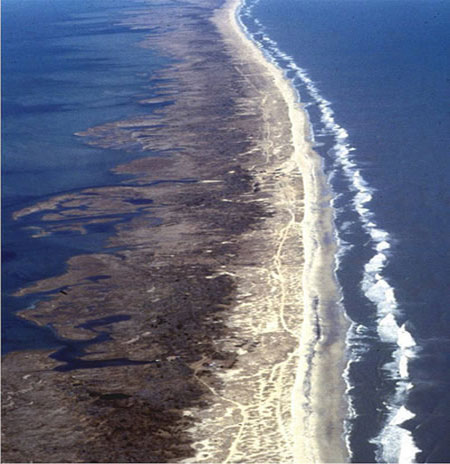Discover 657 new islands around the world
657 new islands have been discovered around the world, according to a new global study conducted by scientists from two universities in North Carolina, USA.
Using satellite images, topographic maps and maritime maps, Duke and Meredith University researchers have determined that Earth has a total of 2,149 barrier islands, 657 more than what you have People still believe before.
The new figure outperforms the total of 1,492 barrier islands identified in the 2001 survey, carried out without the aid of available satellite images.
Barrier islands are long, low and narrow offshore sand strips, parallel to the coast but separated from the shore by gulfs, estuaries or estuaries.

A barrier island in North Carolina, USA.
Unlike static terrain, barrier islands form, erode, shift and re-form over time due to ocean waves, tides, currents and other physical processes in an open marine environment.
The barrier islands around the world have a total length of 21,000km. They are found along all continents, except Antarctica, and in all oceans. The barrier islands equals 10% of the Earth's continental coastline. 74% of these islands are located in the Northern Hemisphere.
Shielded islands help protect low mainland coasts against erosion or damage caused by storms. They can also become important habitats for wildlife. The most island country is America, with 405 islands.
Matthew L. Stutz of Meredith, a member of the research team from Meredith University, said newly discovered barrier islands have existed for a long time but were overlooked or misclassified in previous surveys.
For example, scientists previously believed that barrier islands could not exist in waters with seasonal tides above 4m high. But the new study has determined that the world's longest chain of barrier islands is located along Brazil's equatorial coastline, where the spring tide reaches 7 meters.
The new findings have shown that there is a need for a new measure to classify, study reverse islands, so that scientists can predict which islands are likely to disappear in the future, researchers say. know.
- Discover 9 islands with strange shapes
- The last chance to visit these 12 islands before it completely disappears
- Explore the 'dragon's territory' at the volcanic island of Hawaii
- 8 death islands in the world
- Indonesia has lost 4,000 islands
- Discovered 40 new beetle species in the Tahiti Islands
- The two most inaccessible lands on Earth
- The island is located near the Antarctic of New Zealand
- 10 super small islands with people in the world
- Turtle Island - Colon Islands
- Islands have much higher radioactivity than Chernobyl and Fukushima
- Seychelles Islands - the place with the clearest sea
 Surprised: Fish that live in the dark ocean still see colors
Surprised: Fish that live in the dark ocean still see colors Japan suddenly caught the creature that caused the earthquake in the legend
Japan suddenly caught the creature that caused the earthquake in the legend A series of gray whale carcasses washed ashore on California's coast
A series of gray whale carcasses washed ashore on California's coast Compare the size of shark species in the world
Compare the size of shark species in the world